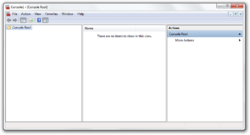This page is currently a draft. Don't link drafts to main pages.
Draft:Microsoft Management Console
| Component of Microsoft Windows | |
 Microsoft Management Console in Windows 7 | |
| File name/executable | mmc.exe |
|---|---|
| Other name(s) | MMC (acronym) |
| Type | Utility manager |
| Introduced in | Windows NT 4.0(Option Pack) Windows 2000(Default) |
Microsoft Management Console (also known as MMC) is an application that provides various options via snap-ins to configure and monitor the system.
Included snap-ins[edit source]
Computer Management[edit source]
Computer Management (compmgmt.msc) lists the most common snap-ins for maintaining integral parts of the computer and the operating system.
Device Manager[edit source]
Device Manager (devmgmt.msc) allows the user to have an overview of all hardware devices that are attached or connected to the computer and allows users to manage and configure them.
Disk Management[edit source]
Disk Management (diskmgmt.msc) allows the user to make changes to the existing disks such as removing drive letters, create volume, etc. and/or creating and managing VHDs.
Local Users and Groups[edit source]
Local Users and Groups (lusrmgr.msc) allows the user to manage local user accounts on the device. It provides a more advanced way to manage accounts than the traditional way.
Local Group Policy Editor[edit source]
Local Group Policy Editor (gpedit.msc) provides a way to disable and/or enable various group policies on the device, including telemetry, app restrictions, etc.
TPM[edit source]
TPM (tpm.msc) provides a quick glance about the system Trusted Platform Module status such as version, status, etc.
Services[edit source]
Services (services.msc) provides a glance about the system services, and also a way to disable or delete them.
Performance Monitor[edit source]
Performance Monitor (perfmon.msc) provides a more advanced method to monitor system resource usage than the Task Manager. It is also be able to pinpoint unusual usages that could impact resource usage.
Task Scheduler[edit source]
Task Scheduler (taskschd.msc) allows the user to run various automated tasks like launching programs or making a custom dialog box pop-up on the screen at pre-defined times or after certain set times.
Server Manager (formerly)[edit source]
Server Manager (previously known as Configure Your Server and Manage Your Server) is a server administration application included in server releases of Windows from Windows 2000 onwards. It provides a user interface that is geared towards modifying certain aspects of a server, such as the installation and configuration of roles and features which include but are not limited to Active Directory, DNS, guest virtualization, website hosting, and storage services.
Since Windows Server 2012 build 7965, it changed again from a MMC snap-in to a standalone executable.